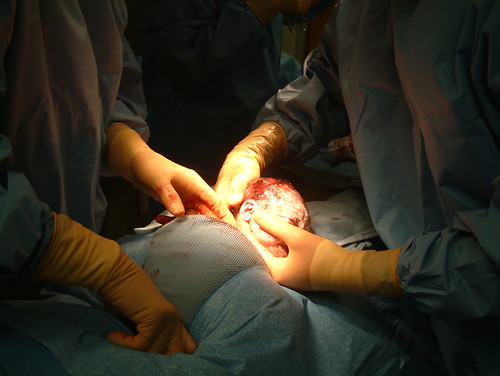
Zoe's Delivery by Mwesigwa
VBAC (Vaginal Birth After Cesarean), or lack of it, is one of the major reasons for America's steadily (or should I say, alarmingly) rising Cesarean rate - currently a whopping 32.8% of all Amercan births end with an incision. Recently Richard Waldman MD, the president of the powerhouse medical organization, the American College of Obstetricians and Gynecologists, made a powerful statement concerning his colleagues quick jump to surgery. This year, at their annual conference he said:
"In 2008 the cesarean delivery rate reached another record high—32.8% of all births. There is a community not far from my home in which 45% of the newborns are delivered via an abdominal incision. [...] Liability dampens our spirits but unfortunately, it is also starting to define our specialty. [...] Let us recommit to do everything in our power to perform surgery only when necessary. Let us recommit to induce only when indicated and let us vow to never electively induce or perform an elective cesarean prior to 39 weeks. Any time we are tempted to take the safe path but not the righteous path, we should all say, “not on my shift."
It is a refreshing statement, one I hope holds up to the testing grounds of hectic and busy maternity wards. In our modern world it often seems that Cesarean is the only "choice" women have in the hospital to keep them and their babies safe. But our bodies have not changed since 1975 when the US Cesarean rate was 10.4%, obstetric training and practice has. Midwives have always been on the side of women and their bodies, learning and studying normal physiological birth in order to safely deliver women, and even now are often the only option for women who desire a chance at vaginal birth.
VBA2C refers to Vaginal Birth After 2 Cesareans. It is an unfortunate fact of life that many women now are in the situation of having had more than one Cesarean, but still long for a vaginal birth with a subsequent pregnancy. ACOG has in its guidelines on VBAC, allowed for a trial of labor with 2 or more Cesareans if a woman has had a vaginal birth before. Now a recent study has shown that even if a woman has not delivered vaginally before, she should still be allowed a trial of labor, even if she's had 2 prior surgical deliveries. In their findings VBAC in these cases, was successful 71.1% of the time. Uterine rupture, of course the sole reason for not allowing for VBACs, increased to 1.36%, which is roughly double what it would be in a woman who has had one prior surgery. But the tone of the researchers was encouraging and prompted practitioners to also caution their patients about the risks of a third repeat cesarean, in the light of these findings. Now that's informed consent.
This is great news for many women. Check out the video below to truly see the joy a successful VBAC can bring to a mother's face. If you want more information on VBACs in general check out this enlightening Cesarean fact sheet.


